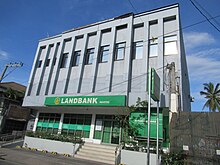Land Bank of the Philippines
[3] In 1965, LandBank's by-laws were approved and its first board of trustees was formed, with the Secretary of Finance as chairman.
27, signed by President Ferdinand Marcos, emancipated all tenant farmers working on private agricultural lands devoted to rice and corn, whether working on a landed estate or not.
The decree expanded LandBank's powers to include lending for agricultural, industrial, homebuilding and home-financing projects and other productive enterprises, as well as lending to farmers' cooperatives and associations to facilitate production, marketing of crops and acquisition of essential commodities.
LandBank was also required by the decree to provide timely and adequate support in all phases involved in the execution of agrarian reform and also increased its authorized capital to ₱3 billion.
It also became exempted from all national, provincial, city and municipal taxes and assessments.
[5] LandBank was reorganized in 1977 when it was divided into three sectors to better assess the needs of its customers.
[7] LandBank became the financial intermediary for the Comprehensive Agrarian Reform Program (CARP) in 1988.
The Aboitiz Group of Companies acquired LandBank's 40% share of UnionBank then which it continues to own.
In 2014, LandBank was planned to be merged with the Development Bank of the Philippines (DBP).
